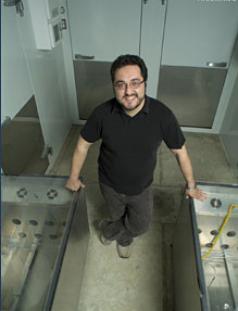Gale Bozzo

Email:
Phone:
Education:
B.Sc. York University;
M.Sc. York University;
Ph.D. Queen’s University
Location:
Room:
Postharvest Biochemistry
Controlled atmosphere (CA) storage is a postharvest management technology designed to limit respiration and ethylene-mediated processes leading to the loss of fruit quality and freshness, and also serves to increase the marketability of climacteric fruit. For some pome cultivars, CA storage may also result in the development of physiological disorders of the fruit surface and/or flesh. My lab is interested in the relationship between oxidative stress metabolism and the onset of physiological disorders in bulky fruit (e.g. apples and pears) during CA storage. Currently, we are focused on developing cultivar-specific strategies for prolonged CA storage of traditional and newly developed pome fruits cultivated in Ontario. To date, the biochemical processes promoting the onset of physiological disorders in response to CA are unknown. To address this, we are conducting studies to determine whether an imbalance in whole fruit redox metabolites (i.e. ascorbate and glutathione) precedes physiological disorders in apple and pears during CA storage.
Secondary Metabolism
An on-going interest in the laboratory is to define biochemical signatures that are pivotal for the modification and/or catabolism of phenylpropanoid pathway end products in planta. Briefly, we are studying the metabolism of the following phenylpropanoid derived products: flavonols, potential human health promoting compounds; anthocyanins, red, blue and purple pigments formed in fruits, flowers and seeds; and proanthocyanidins.
Flavonol Catabolism in Plants
My laboratory is investigating the key biochemical and molecular determinants promoting the loss of flavonols, specifically kaempferol and quercetin bisglycosides in vegetative plant tissues of Arabidopsis thaliana. These bisglycosides accumulate in leaves and roots in response to abiotic stress, and have been shown to rapidly disappear within a few days of stress recovery. To date, the catabolic products of kaempferol and quercetin bisglycosides, as well as the enzymes promoting their loss in Arabidopsis are scantly described. We are using biochemical tools together with functional genomics to elucidate the major enzymatic steps required for the degradation of stress-inducible quercetin bisglycosides.
Seed Coat Darkening and the Phenylpropanoid Pathway
Research aims to determine the key structural and regulatory steps of the phenylpropanoid pathway underlying the seed coat darkening phenomenon in edible dry beans (Phaseolus vulgaris). The oxidation of seed coat proanthocyanidins during the postharvest handling of dry beans culminates in the browning of the seed coat. We are using RNAseq technology to determine the difference in phenylpropanoid pathway gene expression in darkening relative to non-darkening cranberry beans. In addition, we are performing biochemical analyses of the following proanthocyanidin genes from developing cranberry beans: leucoanthocyanidin reductase, anthocyanidin reductase and polyphenol oxidase, in order to determine their relative contribution to the seed coat darkening phenomenon of edible dry beans.
UNDERGRADUATE & GRADUATE STUDENTS
Currently accepting applications for undergraduate and graduate (M.Sc. and Ph.D.) positions.
Courses:
Relevant Links:
Selected Publications:
Freixas Coutin, J.A., S. Munholland, A. Silva, S. Subedi, L. Lukens, W.L. Crosby, K.P. Pauls, and G.G. Bozzo. (2017). Proanthocyanidin accumulation and transcriptional responses in the seed coat of cranberry beans (Phaseolus vulgaris L.) with different susceptibility to postharvest darkening. BMC Plant Biology. DOI: 10.1186/s12870-017-1037-z.
Brikis, C.J., A. Zarei, C.P. Trobacher, J.R. DeEll, K. Akama, R.T. Mullen, G.G. Bozzo and B.J. Shelp. (2017). Ancient plant glyoxylate/succinic semialdehyde reductases: GLYR1s are cytosolic, whereas GLYR2s are localized to both mitochondria and plastids. Frontiers in Plant Science. 8: 601.
Lum, G.B., J.R. DeEll, G.J. Hoover, S. Subedi, B.J. Shelp, and G.G. Bozzo. (2017). Senescent scald and internal breakdown in stored pear fruits are associated with glutathione depletion. Postharvest Biology and Technology. 129: 52-63.
Lum, G.B., C.J. Brikis, K.L. Deyman S. Subedi, J.R. DeEll, B.J. Shelp and G.G. Bozzo. (2016). Pre-storage conditioning ameliorates the negative impact of 1-methylcyclopropene on physiological injury and modifies the response of antioxidants and g-aminobutyrate in ‘Honeycrisp’ apples exposed to controlled-atmosphere conditions. Postharvest Biology and Technology. 116: 115-128.
Lum, G.B., B.J. Shelp, J.R. DeEll and G.G. Bozzo. (2016). Oxidative metabolism is associated with physiological disorders in fruits stored under multiple environmental stresses. Plant Science. 245: 143-152.
Chiu G.Z., B.J. Shelp, S.R. Bowley, J.R. DeEll and G.G. Bozzo. (2015). Controlled atmosphere-related injury in ‘Honeycrisp’ apples is associated with g-aminobutyrate accumulation. Canadian Journal of Plant Science. 95: 879-886.
Ropeke, J. and G.G. Bozzo. (2015). Arabidopsis thaliana β-glucosidase BGLU15 attacks flavonol 3-O-β-glucoside-7-O-α-rhamnosides. Phytochemistry. 109: 14-24.
Deyman, K.L., G. Chiu, J. Liu, C.J Brikis, C.P. Trobacher, J.R. DeEll, B.J. Shelp and G.G. Bozzo. (2014). Effects of elevated CO2 and 1-methylcyclopropene on storage-related disorders of Ontario-grown ‘Empire’ apples. Canadian Journal of Plant Science. 94: 857-865.
Deyman, K.L., C.J. Brikis, G.G. Bozzo and B.J. Shelp. (2014). Impact of 1-methylcyclopropene and controlled atmosphere storage on polyamine and 4-aminobutyrate levels in ‘Empire’ apple fruit. Frontiers in Plant Science. 5: 144.
